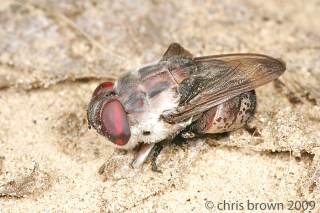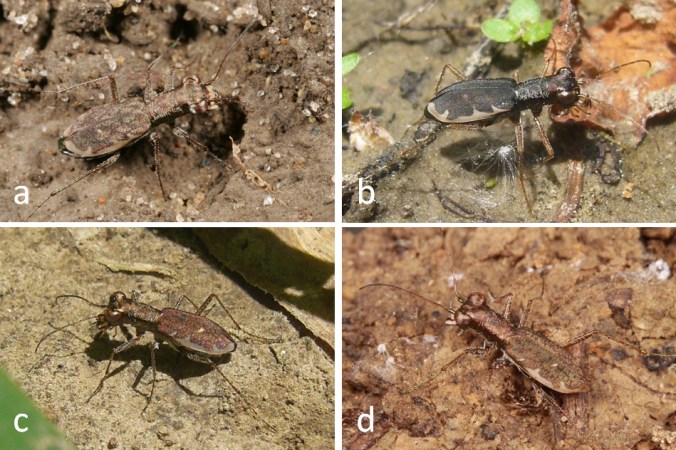As an undergraduate at Truman State University during the mid-90’s I was part of a small mammal research group led by Dr. Scott Ellis. My focus was on flying squirrels, but others in the group studied mice. There were always opportunities to help my colleagues trap mice, and that is where I first encountered bot flies (Oestridae: Cuterebra spp.). It was common for the live trapped mice to be infected with bot fly larvae, or bots, developing just under the skin of the host. You might expect a fly parasite of a mouse to be relatively small but that is not the case with bot flies. The bots cause a grotesquely large growth (or warble), and Cramer and Cameron (2006) report that a single bot can weigh as much as 5% of the host body weight. That’s like a 150 lb guy having a 7.5 lb growth! One unfortunate mouse that comes to mind had a warble on its head which caused its eye to bulge out. I hate to make light of that poor mouse’s condition, but I distinctly recall that the bulging eye made it look as if it was continually surprised. That said, Cuterebra fontinella infections are not thought to have a negative impact on white-footed mice, and in fact some studies have found that infected mice actually live longer than their non-infected neighbors (Cramer and Cameron 2006). This relatively benign relationship between host and parasite is also the case in general with other species of Cuterebra, which is attributed to the long evolutionary history shared between the parasite and a single or very few closely related hosts (Catts 1982). Negative impact or not, I was glad that I didn’t have to worry about bot flies infecting me, at least while I was in temperate Missouri. Of course I had heard plenty of stories of humans being parasitized in the tropics by the human-attacking Dermatobia hominis, and they didn’t sound like very pleasant experiences. My favorite story involved the person that had a bot in their ear that just about drove them crazy because they could hear the bot any time it changed positions. Actually the Slansky article discusses the more negative interaction between D. hominis and its host, and this has been attributed to the less specialized relationship between the parasite and any one host because D. hominis has a broad range of hosts.
Dermatobia hominis actually employ another insect to deliver its eggs to the host! They lay eggs on mosquitoes or other blood-feeding Diptera for subsequent transfer to the host. This makes a lot of sense from my point of view as a potential host—the adults are huge (bumble bee size), and I sure would be wary of one approaching me. But mosquitoes, now there’s an idea—they are very adept at finding their hosts and are inconspicuous enough that they just might be able to get in close enough to allow the body heat of the host to stimulate the hatching and deposition of a bot.
There are other species of Cuterebra, and each is host specific to some degree. Cuterebra abdominalis (Fig. 1) and Cuterebra buccata are both specific to lagomorphs (rabbits). No doubt male tree squirrels and chipmunks get a little nervous every time they hear the species name of their bot fly—“emasculator”. The species name originated from the observation that the warbles were often located near the genitalia of the squirrels, which prompted the idea, given the impressive size of the warble, that there must be an impact on the reproductive ability of the afflicted squirrels. Luckily for the squirrels, research has demonstrated that the species name is a misnomer (Catts 1982).

Figure 1. Cuterebra abdominalis, a rabbit bot fly
I knew nothing of the adult Cuterebra at the time I saw the parasitized mice, but that changed when Ted MacRae netted an adult rabbit bot fly, Cuterebra buccata, while we were looking for tiger beetles in northeastern Missouri. In May of 2006, my wife Jess and I came across an adult C. abdominalis on the edge of a glade at Shaw Nature Reserve near St. Louis, and it is this photo that I discuss more below (Fig. 1). The only other encounter was from southeastern Missouri in April of 2009 when Ted again found a rabbit bot fly, and this individual had only recently emerged from its puparium (Figs. 2 and 3– See Ted MacRae’s previous post from 2009 on this exact same fly). All told, that’s only three encounters with adult bot flies from countless hours spent in the field, so my experience is that adult bot flies are rarely encountered.

Figure 2. Newly emerged rabbit bot fly, Cuterebra buccata

Figure 3. Newly emerged C. buccata with shed puparium
The image in Figure 1 represents well the type of photographic opportunity that I look for because it readily leads into various side stories. Here are some examples:
1) Amazing natural history—you just can’t make this stuff up. The Catts review article cited discusses numerous other aspects of bot fly natural history in addition to the discussion above. For example:
- Cuterebra spp. are thought to oviposit in the host habitat where the eggs await close passage of a host. As with the D. hominis, the body heat of the host stimulates the eggs to hatch. The first instar larvae enter the host through an existing orifice or wound and then travel through the host to find a suitable subcutaneous location to create a warble. Here, the larva molts to the second instar and continues to draw nourishment from the host. Cuterebra larvae feed on fluids of the host as opposed to feeding on actual tissue, which would be more damaging to the host.
- The larvae spend roughly one month in the host. Upon completion of the third instar, the larva exits the host, digs into the soil, and pupates. Bot flies overwinter as pupae.
- Adults do not feed and are relatively short-lived. Their attention is focused on the serious business of reproduction.
2) Mimicry. As you can see from the image, C. abdominalis very much resembles a bumble bee. This image is great for presentations because it captures the attention of grade school kids. I include this image at the end of a series of slides containing images of bees and wasps alongside the flies that mimic them. Kids become very engaged and have a lot of fun trying to guess which images represent the models and which represent the mimics. By the end of the series the kids have become pretty savvy about picking out the imposters but I present this image last and C. abdominalis is so bizarre that it always stumps the audience. The kids become even more captivated by the discussion of how bot flies make a living.
3) Insect photography technique. It’s thrilling to find new insects, but the experience can quickly turn disappointing if the insect flies off never to be seen again just as you begin to approach it for a photograph. That would have been the case with my encounter with C. abdominalis if I didn’t have a companion with me in the field. I was lucky to have my wife, Jess, with me on this hike. She kept an eye on the fly as I moved in for pictures. Once or twice it flew at my approach, and Jess was able to keep track of it so I could try again. Ted and I have also acted as spotters for one another, and this has made the difference between getting the pic or not.
4) Great location. We encountered C. abdominalis on the edge of the scenic glade that slopes away from the Trail House at Shaw Nature Reserve in Franklin County, Missouri. It’s always fun to revisit certain places and get to know them and the photographic opportunities they provide. The Nature Reserve is one such place for me. It offers countless opportunities for insect photography close to St. Louis due to a wide variety of habitats including prairie, glade, forest, wetland, and riparian areas.
REFERENCES:
Catts E. 1982. Biology of New World bot flies: Cuterebridae. Annual Review of Entomology 27:313–338.
Cramer J. and G. Cameron. 2006. Effects of bot fly (Cuterebra fontinella) parasitism on a population of white-footed mice (Peromyscus leucopus). Journal of Mammalogy 86:1103–1111.
Slansky, F. 2007. Insect/mammal associations: Effects of cuterebrid bot fly parasites on their hosts. Annual Review of Entomology 52:17–36.
Copyright © Christopher R. Brown 2012





















